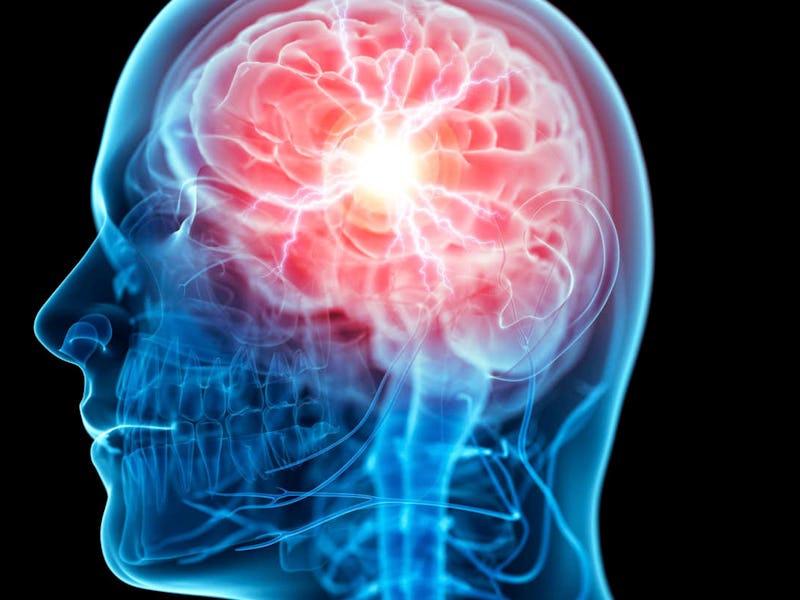Electrode Zaps Could 'Turbo Charge' the Human Brain, Research Shows
We can now alter the way our brains communicate.

For most people with behavior-impairing neurological disorders, medication and behavioral therapies are the go-to treatments, but their effects are limited and can take a long time to work. Fortunately, a new type of therapy has emerged in recent years that offers immediate benefits: transcranial stimulation.
In a study published Monday in the journal Proceedings of the National Academy of Sciences, Robert Reinhart, Ph.D., an assistant professor of cognitive neuroscience at Boston University, shows that a few well-placed brain zaps, delivered through electrodes, could make all the difference between having control and losing it.
Transcranial stimulation works like a tuning fork to get a person’s brain waves to oscillate at an ideal frequency. Operating under the principle that sometimes the waves from different brain areas are not synchronized — thereby causing physical issues — the technique uses magnetic or electrical stimulation to enhance the oscillatory “language” of the brain, helping brain areas operate at the proper frequencies to optimize connectivity.
“Advances like this, in my opinion, are likely to propel the neurosciences forward as rapidly accelerating rates,” Reinhart tells Inverse.
David Somers, a BU professor of psychological and brain sciences who was not involved with the study, says in a statement that the stimulation is like a “turbo charge” for your brain.
Transcranial stimulation, in which the brain is stimulated with electricity to enhance internal signaling, could be the future of neurological therapies.
In particular, Reinhart’s study demonstrates that transcranial stimulation could provide near-immediate improvements for people living with cognitive difficulties who have problems with adaptive control — the ability to adjust one’s actions receiving negative or unexpected feedback.
In the study, Reinhart attempted to enhance functional connectivity between the medial frontal cortex and lateral prefrontal cortex, areas that are associated with adaptive control, at least when they’re functioning together. To do this, he used “nine-channel high-definition transcranial alternating current stimulation (or HD-tACS)” at the frequency of theta brainwaves — about 6 Hz — while 90 test subjects, average age 27, completed different attention and reasoning tasks.
When the transcranial stimulation delivered a signal that was in phase with the subjects’ brains — meaning the peaks and valleys of electrical activity in brain waves matched up with the peaks and valleys in the artificial signal — the subjects were clearly better at the tasks. They made fewer errors, and even when they made errors, the errors were not as bad.
But when subjects were stimulated with an an antiphase signal — meaning that the artificial signal’s peaks and valleys were the reverse of subjects’ natural signals — they performed much worse. These negative results quickly went away, though, when the antiphase signal stopped. Reinhart also used a “sham” stimulus as a control, which neither improved nor diminished subject’s performance on tasks.
The associated connectivity is shown below.
This diagram shows how subjects' brains reacted to an antiphase stimulus (top), a sham stimulus (middle), and an inphase stimulus (bottom).
As shown in the diagram above, functional connectivity between a subject’s medial frontal cortex and lateral prefrontal cortex was greatest when they received stimulation with a theta frequency signal that was in phase with their own brain waves.
Reinhart says this research could provide therapies for people who live with neurological disorders of various types.
“For example, schizophrenia is widely associated with functional connectivity deficits in frontal cortex,” he says. Therefore, synchronizing brain activity among regions could help them function better. But more connectivity isn’t always better, which is why the antiphase signals could be helpful for some people.
“There are other disorders, such as epilepsy, that are associated with hyper connectivity and thus we can imagine our montage that de-synchronizes brain activity in frontal cortex may be potentially useful for treating functional connectivity that is overactive and driving symptoms in epilepsy,” Reinhart says.
“The hope is that basic science such as this will provide important new groundwork for developing methods for rectifying frontal cortical connectivity abnormalities in a variety of brain disorders.”
If you liked this article, check out this video about LSD’s effects on the brain.